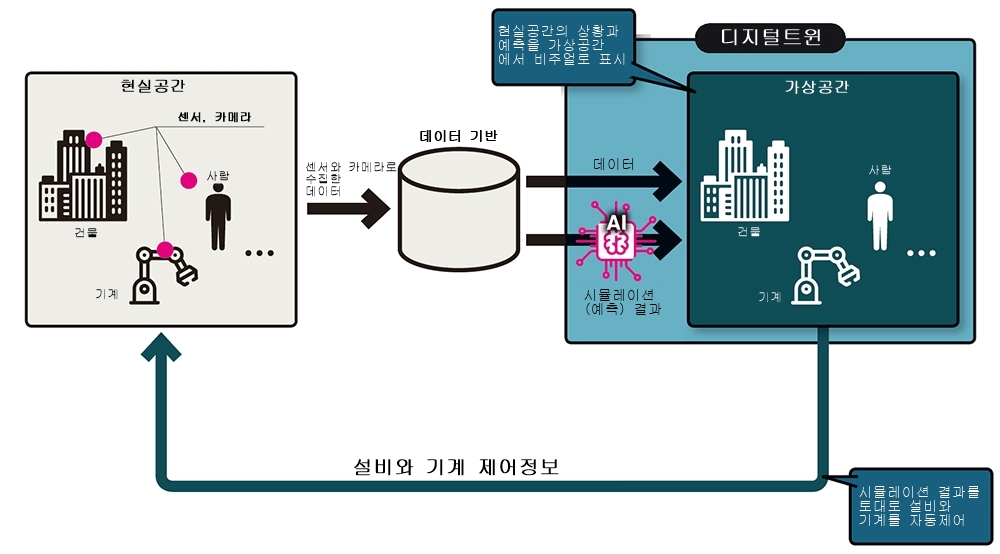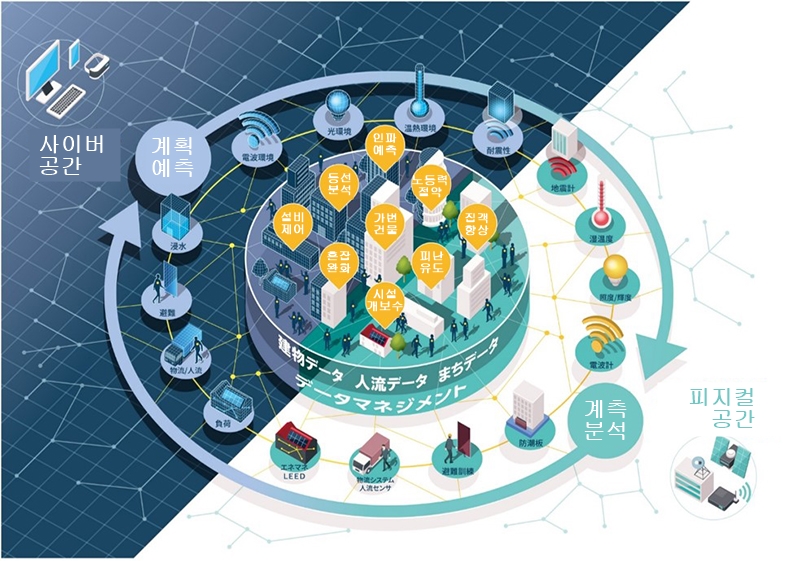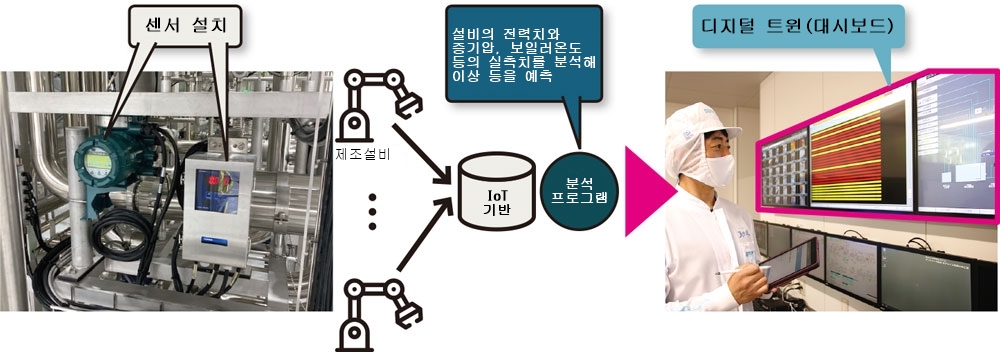– Expansion of movement to utilize digital twin for manpower shortage
– Focus on digital twin, element technology, which is an intensive chain of various technologies
In Japan, the introduction of digital twins is expanding centered on manufacturing, construction, and distribution. Digital twin, which predicts the future in virtual space by acquiring data from real space with high accuracy and frequency, is emerging as one of the new trends in DX.
Reflecting changes in virtual space in reality
Digital twin is to reproduce objects and people in real space in virtual space. Sensors and cameras are attached to buildings, equipment, and products in real space, and the acquired data is integrated into a data base, and buildings, machines, and products are reproduced in virtual space based on these data.
<Overview of Digital Twin>

[Source: Nikkei XTech]
The characteristic of digital twin is that it dramatically increases the range, accuracy, and frequency of data acquisition compared to existing production management systems and building management systems. There are two major advantages of this, one is that the data is easy to visualize. By aggregating sensor data, it is possible to see the status of equipment and products and work progress at a glance, or to visually verify defects by displaying buildings and equipment in three dimensions. It can also determine the condition and issue work orders from a remote location as if you were on-site.
Another advantage is that it is possible to predict the future based on the collected data with high accuracy and frequency. Through machine learning based on the collected data, it predicts equipment failures and work progress, and reflects the results in the virtual space. In other words, the future prediction of the real space is reflected in the virtual space. Through this, it is possible to quickly respond to problems such as equipment failure and production line congestion. In a more advanced form, the AI installed in the digital twin system sends control signals to facilities and machines based on the simulation results for automatic operation. are moving for
Digital twin used in building operation
In order to increase the productivity of construction work, Takenaka Engineering Co., Ltd., a large Japanese construction company, has established and utilized various digital twins in the procedures from building sales to design, production preparation, construction, and maintenance. One of those systems, the Construction Digital Platform, integrates and utilizes all data related to the business, including data from existing key systems such as personnel and finance, and data collected from construction sites with IoT devices in storage.
The digital twin function of the construction digital platform includes reproducing in a virtual space using BIM (Building Information Modeling) data of a building to be built. It is used in the construction and construction stage, and has the purpose of increasing the consistency of design and construction of buildings. Takenaka Engineering & Construction creates a digital twin by creating BIM data in each design process and applying them to the virtual space. Through this, it is used to check the shape of the pipe, such as whether it does not protrude from the wall, and to simulate the structure in which heat cannot escape.
<Image of the building community of Takenaka Gongmu Branch>

[Source: Takenaka Industrial Store]
Another digital twin 'Building Commune' is used in building operation after completion. It collects data such as illuminance, room temperature, and humidity for each room from the lighting and air conditioning system in the building, and monitors the brightness and air condition of each room based on the data stored and collected in the data store to remotely control lighting and air conditioning in real time. Takenaka Kogmu Branch is strengthening the function of building community for the realization of a smart building, one of which is improving the efficiency of lighting and air conditioning. After using BIM data to reproduce the internal structure of a building in a virtual space, the sensor installed in the room collects the brightness and temperature of the lighting in real time to the building community, and processes the collected data in a machine learning model to obtain preset brightness and room temperature. Remotely control lighting and air conditioning to keep power consumption to a minimum. According to Takenaka Engineering & Construction, the building community's AI program has reduced power consumption by about 26% in lighting equipment and 14% in air conditioning equipment.
Detect abnormalities in manufacturing facilities in advance with digital twin
Manufacturing is one of the leading sectors in the digital twin. Suntory Food International, a soft drink manufacturer, introduced an IoT base with a digital twin function to the Suntory Natural Water Northern Alps Shinanonomori Plant, which has been in operation since May 2021. After integrating various data on the manufacturing process (facility, procurement, manufacturing, quality control, shipping, etc.) into the IoT base, based on this, visualization and product tracking in the factory were realized.
Sensors such as flowmeters and conductivity are attached to the facilities of the new factory to acquire data, accumulate these data in the data base, and display the status of manufacturing facilities on the dashboard screen. Predict the abnormalities of manufacturing facilities. In the new factory, each product can be tracked with which equipment and which parts are manufactured, and tracking information is displayed on the dashboard. Therefore, even if defective products are mixed with more than the equipment, information such as which equipment was manufactured, where the products manufactured in which equipment are located, and in which box they are packaged can be tracked on the dashboard screen.
<Suntory Foods Manufacturing Management Dashboard>

[Source: Nikkei XTech]
The digital twin is also used for maintenance of factory facilities. In the new plant, a system was built to monitor the equipment status in real time with sensor information installed in the equipment. When the data of each facility is likely to exceed the threshold, a notification is displayed on the dashboard screen of Digital Twin. Full-fledged operation has obtained valid results from the beginning of operation and the identification of causal relationships of equipment abnormalities.
implication
The digital twin is attracting attention as an effective means to improve productivity in various industries that are struggling with a shortage of manpower. However, for many companies, the establishment of a digital twin is only the beginning. “In order for a company to adopt a digital twin, it is important for IT engineers to not only understand the challenges of the business unit, but also to acquire new technical skills for DX,” points out I analyst at G Research. This is because digital twins require a combination of various technologies.
In the digital twin, a sensor and a camera with communication function must be installed first, and a dedicated data base and large-capacity storage to process the generated data are also required. Cloud utilization is also essential. In addition to these foundations, it is a system that requires comprehensive technologies such as machine learning models and 3D modeling.
Although it is a field that is just being formed, as it is a focused field where various element technologies are concentrated, it would be good for Korean companies to focus on element technologies that can differentiate them from other companies' products and try to knock on the door of the Japanese market.



